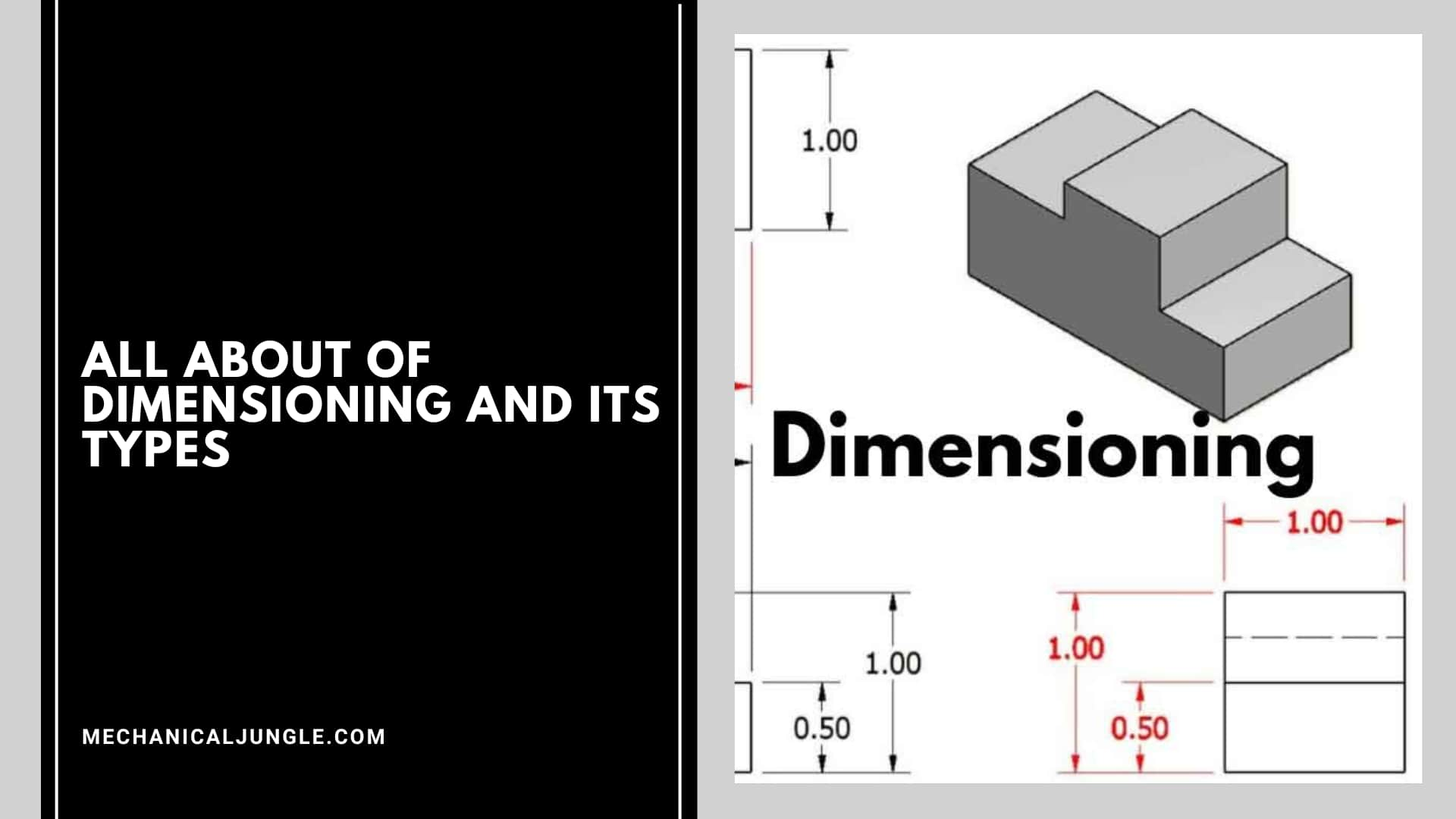
What Is Dimensioning and Its Types?
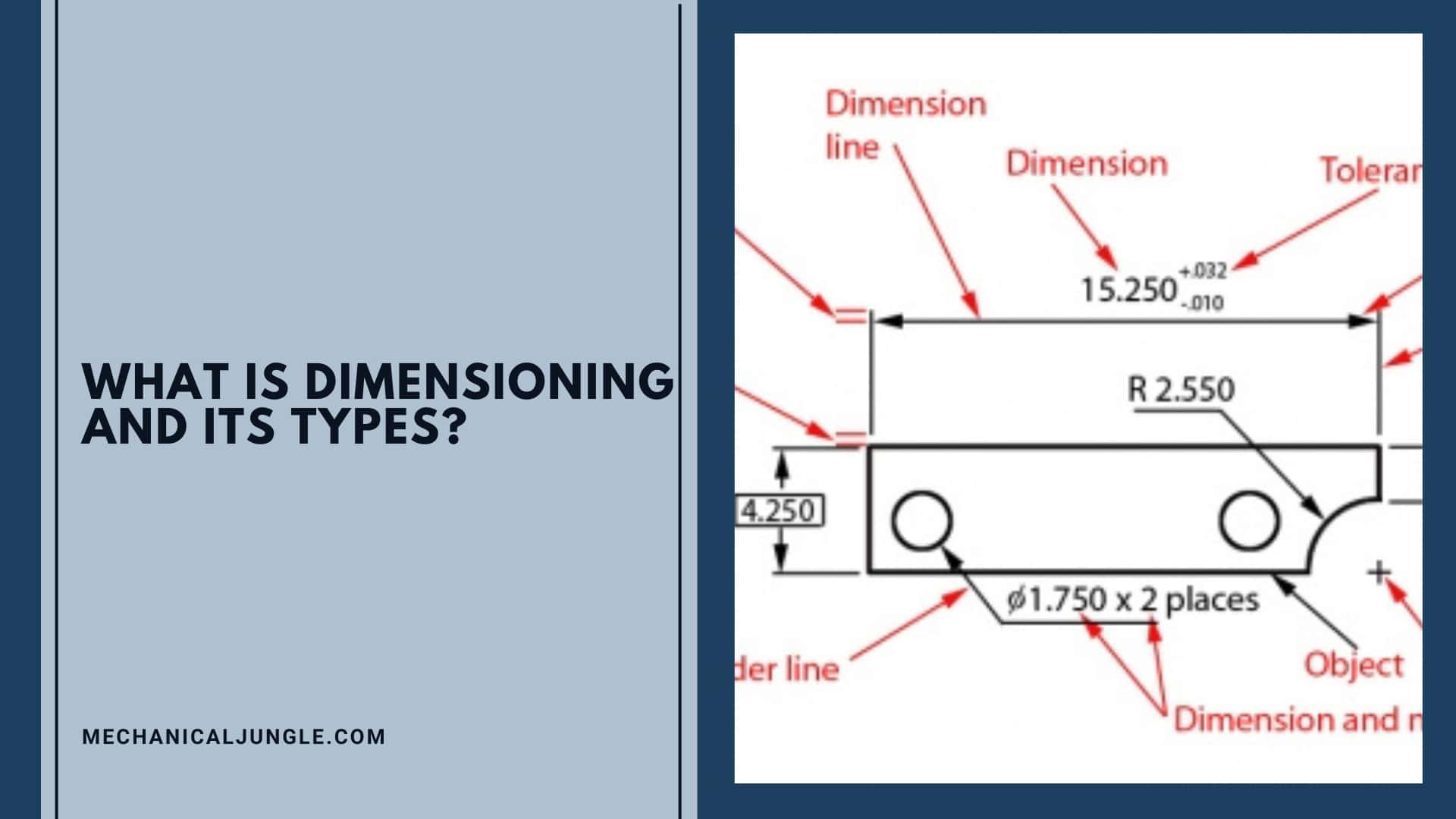
Basics type of dimension is linear, radial, angular, coordinate, and arc length. Use the DIM command to automatically create dimensions according to the object type you want to dimension.
Dimension style allows you to quickly specify your conventions and maintain industry or project dimension standards.
How Many Types of Dimensioning Are There?

Dimensioning a drawing is about adding dimension, notes, & lines to a drawing. There are four methods: parallels, running, chains, & combined amplitude. Some methods of dimensioning a drawing can produce an accumulated error. This occurs when multiple tolerance errors are added together.
What Is Meant by Dimensioning?

Dimension is the process of measuring the area or volume of an object. It is the method of calculating capacity for storing, handling, transporting, and invoicing goods.
Dimensioning:

After preparing the sketch of any drawing, some information has to be written on it. For example, the distance between different surfaces, location of pores, number of holes, type of material, etc. Such information is presented as bylines, numerals, symbols, and notes.
The writing of the measurement of such information is called dimension. By dimensions, the shape & size of an object is explained. A worker can complete works according to the dimension.
If the size of objects is represented, then such a measure is called a size dimension; similarly, if the location of an object is represented, then such a measurement is called a place dimension.
If the dimensions are written in one direction throughout the diagram, then such a method is called the unidirectional method.
If the dimension is written in two directions, such a method is called the align method. Also, if it is written as the dimension parallel to the central line, then such a method is called the baseline method. The beauty of a drawing depends upon the fineness of the dimension.
Types of Dimensioning:
Ther is two types of writing dimension on drawing.
- Size Dimension.
- Location Dimensions.
1. Size Dimension
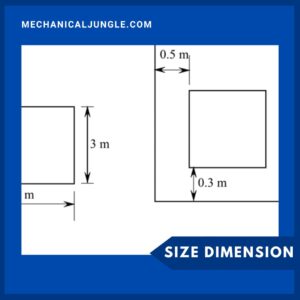
In this type of dimension, the external shape of an object is represented. Also, the sizes of different parts of a drawing are shown there. It shows length, width, and height. This type of dimension is mostly represented by the front view.
2. Location Dimensions
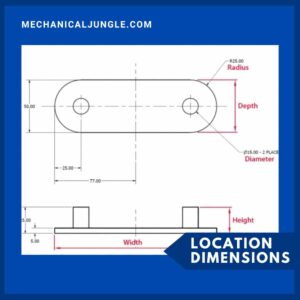
In this type of dimension, the distance between different parts of the object and the distance between the centers of the circles are shown. In addition, the distance of the center or any other part of circles from a particular point is represented. The location dimension is divided in three different ways:
- Center to center distance.
- The distance from the center to the surface.
- Surface-to-surface distance.
Order of Dimensioning:
After completing a drawing, the following sequence is to be kept in mind. It makes the picture beautiful. This also saves time.
- Drawing of extension line.
- Drawing of Dimension Line.
- Drawing of arrowheads.
- Writing the numerical value.
- Drawing of the cutting plane line.
- Drawing of the leader line.
- Drawing the centerline.
- Writing of notes and specifications.
Systems of Dimensioning:
The following are three systems of writing dimension.
#1. Unidirectional Method
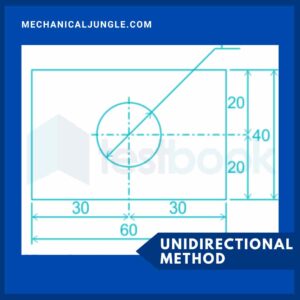
This method is mostly used in dimensioning. In this method, the entire dimension is written in one direction throughout the drawing. This direction is usually perpendicular.
#2. Align Method
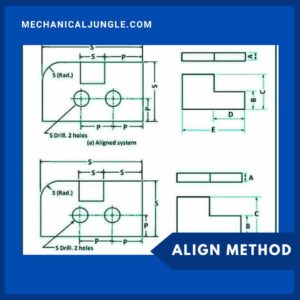
This method of dimensioning is written in two directions throughout the drawing. It is written on the top and right side and read from the bottom and right side of a drawing. This has the advantage that the dimensions can be written in the horizontal direction, which is very easy to write.
#3. Base Line Method
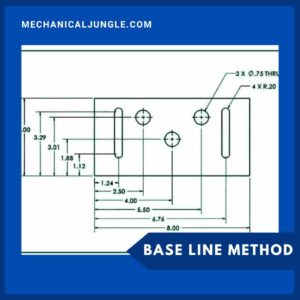
In this dimensioning method, the baseline is used to write the dimensions of the different parts of the drawing. Then all dimensions are written parallel to the baseline.
In the writing dimension, the smallest one is written on the side of the object, and the largest one is written on the outer side of the object. All other dimensions are written in between them. In this system, the chances of mistakes are very less.
Elements of Dimensioning:
For any drawing to be practical, it is necessary that it has all the necessary dimensions written on it so that all the information can be used correctly. For this purpose, the following element is written below.
#1. Dimension Line

Dimension lines are drawn for a given dimension of an object. This line should be at distances of 10 mm to 15 mm from the object line.
To write the dimension, this line is broken from the middle, and the dimension is written in the middle space. Alternatively, dimensions are written on it after its completion. For this, 2H or 4H pencils are used.
#2. Extension Line

Lines that are drawn extending from the ends of a part of the drawing so that the dimension between them can be written are called extension lines. For this, 2H or 4H pencils are used. There should be distances of 1 mm between them & the objects line.
#3. Center Line
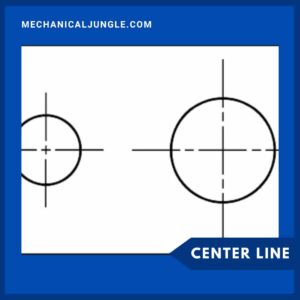
Such a line is used to represents the center of the cylindrical part of a picture. For example, a hole shaft, etc. It should be extended to a distance of 1 mm from the object line.
#4. Leader Line

With the help of this line, a note or specification is written on an object. It is drawn with a 2H or 4H pencil. It consists of a circle & a leader.
#5. Arrow Head
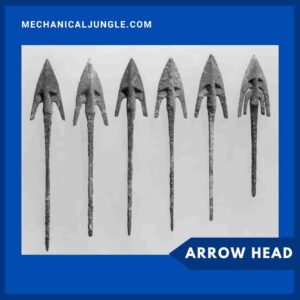
It is used at the end of dimensions and at the end of a leader. The length of the arrowheads used in engineering drawings is 3 mm.
#6. Numbers
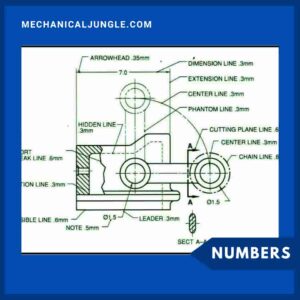
After the completion of any geometrical figure of an object, the writing of its shape is desired. Numbers are used for this. The height of the number is kept at 3 mm.
Principles of Dimensioning:
After completing a drawing, it is essential that its measurements and notes be written in such ways that they can be read easily. Follow the principles designed for this purpose. Dimensions should be given on a scene that reflects the actual size and shape of an object.
As far as possible, dimensions should be given outside a scene but may also be given inside if unavoidable. All dimensions are given in group form. Their distribution is not correct. Dimensions should be written sensibly.
All dimensions should be written parallel to the object line, and numbers should be written in such a way that they are easily read. Dimensions should not be repeated unless necessary. Unnecessary dimensions should be avoided.
Under no circumstances should the extension and dimension lines intersect. When assigning dimensions after completing a drawing, it should be noted that no unit should be written with any number.
Numbers should be clear, legible, and understandable. Circles, arcs, and perfects should correspond to the radius of their diameter. If it is necessary to give dimensions to concentric circles, try drawing them on the front view and then write down their dimensions.
Leaders’ lines should be used to write the dimensions of the circles, which should make their diameter clear. Ambiguous and complex dimensions should be avoided.
FAQ: Dimensioning
What Is Dimensioning in Technical Drawings?
Dimensioning is the process of adding measurements, notes, and lines to a technical drawing to convey the size, shape, and location of features within the drawing. It provides essential information for manufacturing or construction.
What Are the Basic Types of Dimensions?
The basic types of dimensions are:
- Linear: Measures length, width, or height.
- Radial: Measures the radius of circles or arcs.
- Angular: Measures angles between lines or surfaces.
- Coordinate: Measures positions in a coordinate system.
- Arc Length: Measures the length of an arc.
What Are the Four Methods of Dimensioning a Drawing?
The four methods of dimensioning are:
- Parallels: Dimensions are placed parallel to each other.
- Running: Dimensions are placed continuously along a line.
- Chains: Dimensions are placed in a sequence, with each dimension extending from the previous one.
- Combined Amplitude: Combines various methods to suit specific needs.
What Is the Difference Between Size and Location Dimensions?
- Size Dimension: Represents the overall size and shape of an object, including length, width, and height.
- Location Dimension: Specifies the positions of features relative to each other or to a reference point, such as distances between centers or from a surface.
What Are the Three Systems of Dimensioning?
- Unidirectional Method: All dimensions are written in a single direction, typically perpendicular to the drawing.
- Align Method: Dimensions are written in two directions, aligned with the drawing’s features, usually read from the bottom and right.
- Base Line Method: Dimensions are referenced from a baseline, and all measurements are written parallel to it.
What Elements Are Essential for Dimensioning a Drawing?
Essential elements include:
- Dimension Line: Shows the length of the dimension.
- Extension Line: Extends from the object to the dimension line.
- Center Line: Indicates the center of circular features.
- Leader Line: Connects notes or specifications to features.
- Arrowhead: Indicates the end of dimension lines.
- Numbers: Represent the actual measurements.
What Are Some Principles to Follow in Dimensioning?
- Dimensions should be clearly legible and avoid clutter.
- Place dimensions outside the drawing if possible, and ensure they are parallel to the object line.
- Avoid intersecting extension and dimension lines.
- Use leaders to clarify complex dimensions and avoid unnecessary repetition.
How Should Dimensions Be Written to Avoid Errors?
- Use consistent dimensioning methods and styles.
- Ensure that all dimensions are clearly labeled and unambiguous.
- Check for and correct any potential errors or overlaps in dimensions.
When Should Dimensions Be Placed Inside or Outside the Drawing?
Dimensions should generally be placed outside the drawing for clarity. However, if space constraints or drawing details make it necessary, placing dimensions inside is acceptable.
What Tools Are Commonly Used for Dimensioning?
Common tools include drafting pencils (e.g., 2H or 4H), rulers, and digital drafting software that provides automated dimensioning features.

